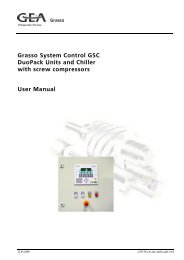FAS622en_pH measurement
Create successful ePaper yourself
Turn your PDF publications into a flip-book with our unique Google optimized e-Paper software.
3 Quality assurance<br />
Drifting measured values<br />
The phenomenon referred to as „drift“ is a normal characteristic of an electrode. The <strong>measurement</strong><br />
setup (or, in the case of a control system, the hand-held meter) indicates permanently increasing or<br />
decreasing <strong>pH</strong> values.<br />
Measured variable<br />
Ref. value<br />
Meas. value<br />
Observation period<br />
Fig. 15:<br />
Drifting measured values<br />
The cause of the drift is normally the reference electrode. Loss of electrolyte, increasing sensitivity<br />
to flow, and also contaminations, change the potential of the electrode. This change in potential<br />
shows itself in the drift of the <strong>measurement</strong> setup. The drift caused by the electrolyte loss accelerates<br />
at the end of the service life to such an extent that it can only be remedied by changing the<br />
electrolyte solution or the electrode.<br />
Poisoning may occur if, for instance, sulfide ions penetrate the reference electrode from the water,<br />
thereby converting the silver/silver chloride system into a silver/silver sulfide system, or block the<br />
diaphragm. Cyanide ions can damage the silver/silver chloride system, as they dissolve the silver<br />
chloride.<br />
Electrolyte consumption and contamination cause a pronounced shift in the system zero during<br />
calibration. A sensitivity to flow is often not noticeable during calibration. The effect can be seen<br />
more clearly by moving the electrode gently in the water. The value indicated by the setup when<br />
the electrode is being moved is different from the value when the electrode is kept stationary.<br />
28 3 Quality assurance JUMO, FAS 622, Edition 04.07














